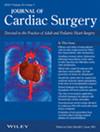Subannular procedures on papillary muscles for secondary mitral valve regurgitation repair
IF 1.3
4区 医学
Q3 CARDIAC & CARDIOVASCULAR SYSTEMS
引用次数: 0
Abstract
Mitral valve disease is a frequent cause of heart failure and death. The mitral valve must be seen as a complex apparatus made up of valve flaps, annulus, and subannular structures such as tendon cords and papillary muscles (PPM) (dependent on left ventricular [LV] performance). Emerging evidence indicates that the mitral valve is not a passive structure, but even in adult life remains dynamic and accessible for treatment. This concept motivates efforts to reduce the clinical progression of mitral valve disease through early detection and modification of underlying mechanisms. Functional mitral regurgitation is a condition characterized by mitral regurgitation secondary to an ischemic left ventricle or cardiomyopathy. Primarily, the pathology is the result of the perturbation of normal regional LV geometry combined with adverse remodeling. Although the surgical treatment of severe chronic secondary mitral regurgitation (sMR) in patients presenting for coronary artery bypass grafting (CABG) is recommended by the American College of Cardiology/American Heart Association guidelines, the surgical approach remains debated. Many investigators advocated mitral valve restrictive annuloplasty (RA), meanwhile others have suggested mitral valve replacement. Investigators supporting a conservative approach believe that conservation of the continuity between the valve and left ventricle lead to better long‐term results and a reverse in LV remodeling. 2 | EVIDENCE ON ISCHEMIC MITRAL REGURGITATION (iMR)

乳头肌环下手术修复二尖瓣二次返流
本文章由计算机程序翻译,如有差异,请以英文原文为准。
求助全文
约1分钟内获得全文
求助全文
来源期刊
CiteScore
2.90
自引率
12.50%
发文量
976
审稿时长
3-8 weeks
期刊介绍:
Journal of Cardiac Surgery (JCS) is a peer-reviewed journal devoted to contemporary surgical treatment of cardiac disease. Renown for its detailed "how to" methods, JCS''s well-illustrated, concise technical articles, critical reviews and commentaries are highly valued by dedicated readers worldwide.
With Editor-in-Chief Harold Lazar, MD and an internationally prominent editorial board, JCS continues its 20-year history as an important professional resource. Editorial coverage includes biologic support, mechanical cardiac assist and/or replacement and surgical techniques, and features current material on topics such as OPCAB surgery, stented and stentless valves, endovascular stent placement, atrial fibrillation, transplantation, percutaneous valve repair/replacement, left ventricular restoration surgery, immunobiology, and bridges to transplant and recovery.
In addition, special sections (Images in Cardiac Surgery, Cardiac Regeneration) and historical reviews stimulate reader interest. The journal also routinely publishes proceedings of important international symposia in a timely manner.

 求助内容:
求助内容: 应助结果提醒方式:
应助结果提醒方式:


